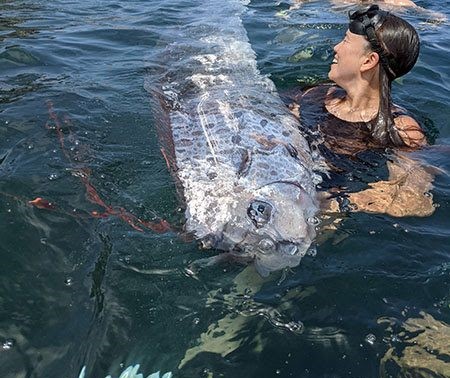
The ultra-rare find of a deep-sea creature known as an oarfish in the water off La Jolla Cove started a frenzy among scientists who have swarmed to find out more about the mysterious deceased fish.
The serpent-like oarfish found Aug. 10 is 12 feet long and will become part of the Marine Vertebrate Collection at UC San Diego’s Scripps Institution of Oceanography in La Jolla, where scientists will be able to study it further.
Oarfish have been seen only about 20 times in California since 1901, and according to Scripps Oceanography, experts don’t have enough evidence to theorize why they would wash up in Southern California.
Scientists from SIO and the National Oceanic and Atmospheric Administration’s Southwest Fisheries Science Center turned out for a necropsy on the La Jolla oarfish Aug. 16.
“Oarfish always spark a lot of interest because they are a unique fish — they can be 25 feet long and have this beautiful silvery body and red fins,” said Scripps Oceanography fish expert Ben Frable. “But beyond their looks, they can reach large sizes in the deep sea where there is not a lot of light or plants and where you wouldn’t typically see large fish. So they seem to have a filter feeding system like baleen whales.”
“For us in California, they don’t show up often,” he said. “But they are not rare globally. They wash up all over the place but are more common in Japan. For us, this is a less-common member of our offshore community and may only be here during certain climatic conditions or certain times of year.”
As the scientists gathered to try to understand the fish better, “there were different people interested in different facets of the fish,” Frable said. “We have people interested in how they feed or how the bones support their gills, so we took samples of different tissues to look at genomics and answer various scientific questions. We wanted to give as many scientists access [as possible]. It was pretty astounding getting that many people together.”
Frable, whose interest is in genetics, took tissue samples that will be analyzed, and he will preserve the specimen afterward so other scientists can see it and ask questions.
“We want to look at the role they play in the open-ocean ecosystem as a predator of small things,” Frable said. “So when we have a specimen, we can get into the questions that we can’t ask without it. We can learn about its anatomy and tease out the role in the ecosystem globally and use it as a puzzle piece about the open-ocean ecosystem.”
Given that 70 percent of Earth’s surface is ocean, most of it far offshore, having a better understanding of its systems and species “can help us understand broad-scale cycles in the open ocean. You can ask big, big questions from that and start to get answers from that.”
Frable has been part of the team that studied a Pacific footballfish, an extremely rare species of anglerfish, when it washed ashore in San Diego County in 2021 and discovered a new fish species, the tailspot wrasse, off Mexico’s Pacific coast in 2022.
So when he got the call that an oarfish had been found nearby, “it was that same exhilarating feeling,” he said. “It was very exciting, and I have been fortunate enough to be here in Southern California and San Diego where, due to the environment and the features of the ocean, deep-water animals interact with us more than other places on the coast.”
Because the oarfish has “so many folks … involved and engaged, it would be really fantastic to try and compile everything that came from this one fish so it can inform other forms of science,” Frable said. “One thing can tell you a lot, but it won’t tell you everything. Thankfully a lot of other scientists are studying this in other parts of the world. We can learn a lot, but we can learn a lot more.”
Anyone who finds a unique creature like the oarfish on or near the beach can alert lifeguards and/or notify the Scripps Institution of Oceanography at [email protected] or (858) 534-3624. ♦
Originally Published:



